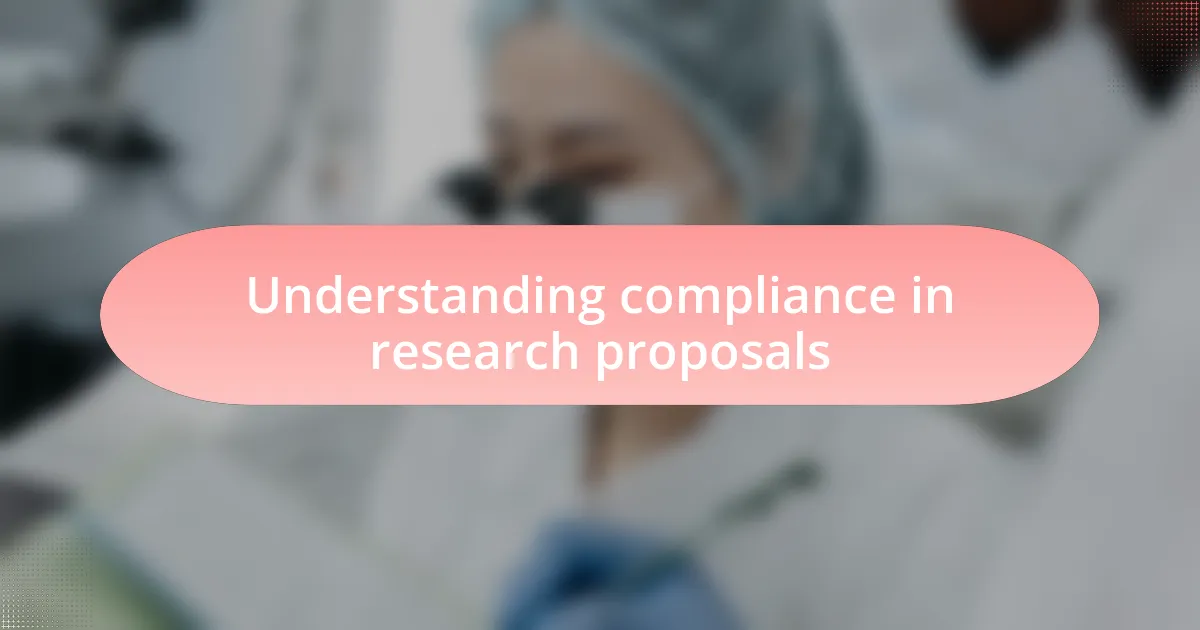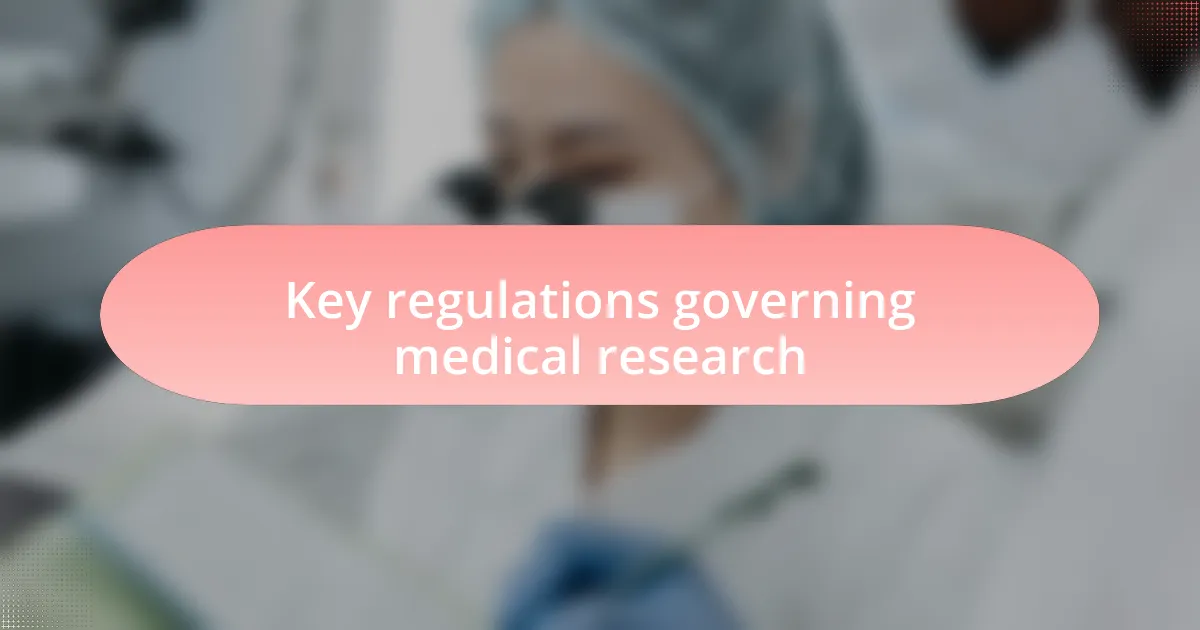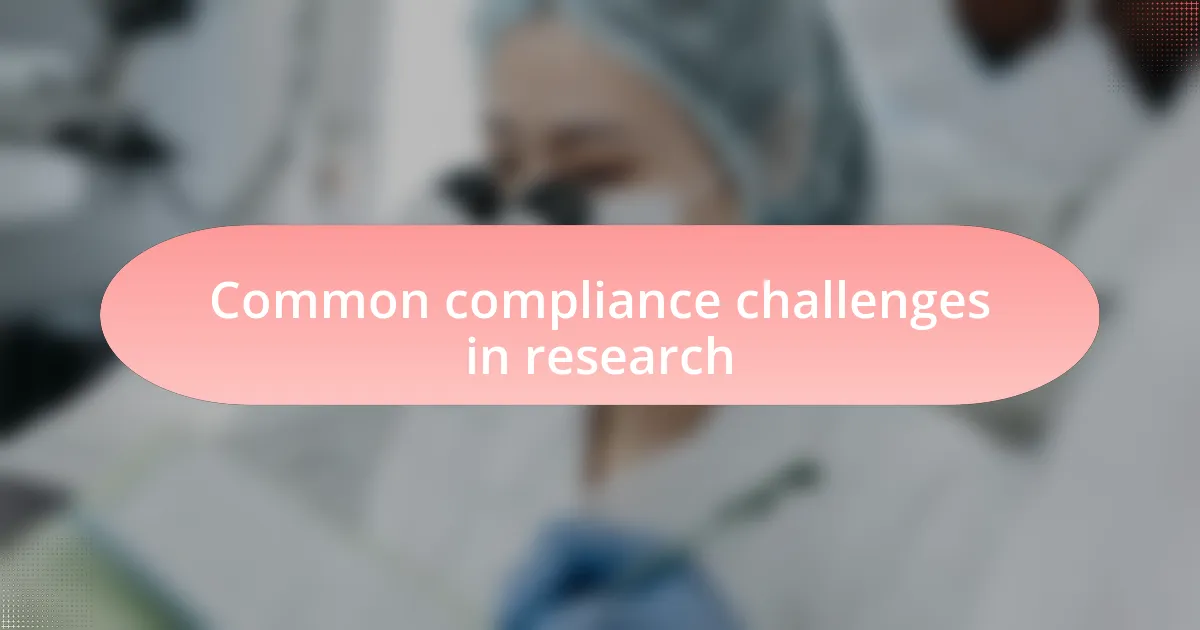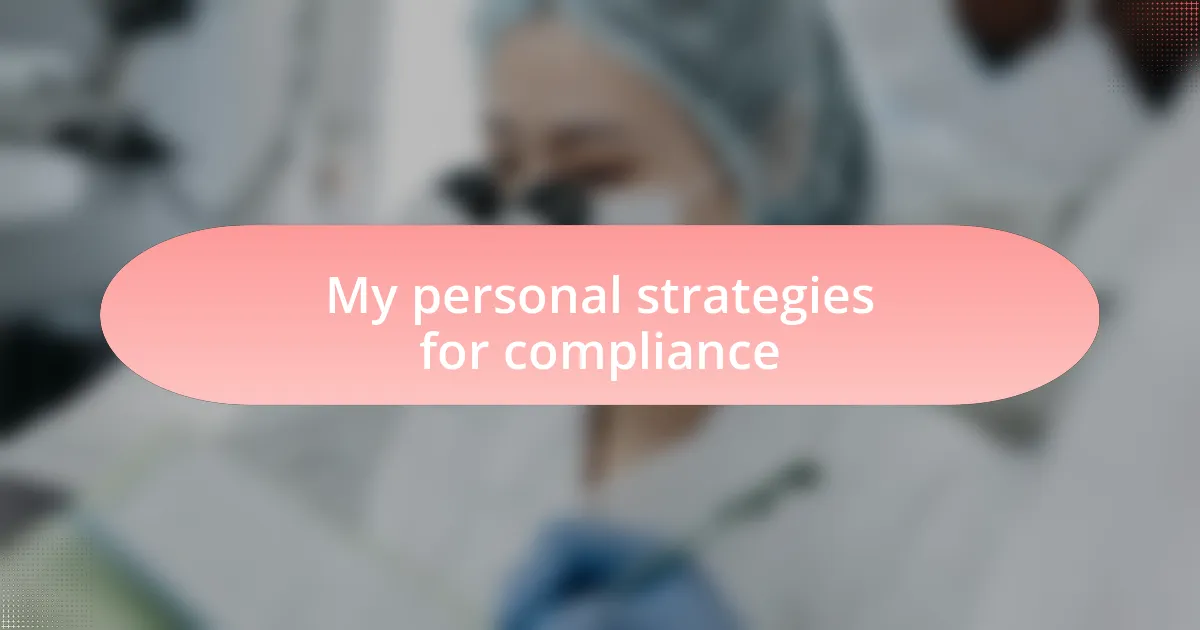Key takeaways:
- Compliance in research is essential for ethical practices, participant safety, and building trust within the research community.
- Key regulations such as HIPAA and the Common Rule guide the protection of participant rights and safety in medical research.
- Common challenges include varying institutional interpretations of guidelines and funding limitations impacting adherence to compliance standards.
- Effective strategies for ensuring compliance include meticulous planning, fostering open communication within research teams, and prioritizing continuous education.

Understanding compliance in research proposals
Understanding compliance in research proposals goes beyond merely checking boxes. I remember when I was knee-deep in preparing a significant grant application, feeling overwhelmed by the myriad of regulations. It struck me that compliance isn’t just a formality; it’s about fostering ethical research that respects the rights and well-being of participants.
Every time I submit a proposal, I reflect on the ethical implications of my work. I often ask myself: “Are we truly prioritizing participant safety?” It’s crucial to ensure that our research adheres to established guidelines, ensuring transparency and accountability. When I first navigated these waters, I found that engaging with ethics committees provided invaluable guidance, reinforcing my commitment to compliance.
Adhering to compliance standards also instills confidence in stakeholders. I recall presenting a proposal that was meticulously aligned with compliance requirements. The positive feedback I received from my peers and sponsors reinforced the idea that adherence signals professionalism and respect for the scientific community. Ultimately, understanding compliance is about equipping ourselves to conduct impactful and responsible research.

Key regulations governing medical research
Key regulations governing medical research are designed to protect both participants and researchers, ensuring the integrity of the study. I remember my first encounter with the Institutional Review Board (IRB), where I learned firsthand how essential their role is in safeguarding the rights and welfare of participants. The process was rigorous, but it made me appreciate that a thorough review isn’t just a hurdle; it’s a safeguard that builds trust within the research community.
One of the most critical regulations I encounter is the Health Insurance Portability and Accountability Act (HIPAA). Understanding HIPAA’s privacy provisions was a game-changer for me. It not only changed how I managed confidential patient data but also encouraged me to adopt a more diligent approach in my research practices. I often wondered how many researchers overlook these regulations; I know I would have if I hadn’t actively sought guidance.
Moreover, the Common Rule lays out essential requirements for research involving human subjects. Reflecting on my experiences, it’s clear that compliance isn’t merely about following rules; it involves a deep respect for participants’ autonomy and safety. Whenever I craft a new proposal, I ask myself: “Am I honoring their rights?” The answer to that question is critical, and the regulations serve as a framework to help ensure that I always prioritize participant welfare in my work.

Common compliance challenges in research
Common compliance challenges in research often stem from the nuances of navigating ethical regulations. I recall struggling with informed consent forms in my early research days; ensuring that participants fully understood what they were signing could feel overwhelming. It posed a real dilemma: how do you balance the need for comprehensive information with a participant’s ability to digest it? I realized that clarity is key, but the intricacies of legal jargon can complicate even the best intentions.
Another hurdle is the varying interpretations of compliance guidelines across institutions. During a multi-site study I was involved with, I faced the frustration of aligning IRB requirements from different universities. Each site had its own nuances that made compliance feel like an endless maze. I learned that open communication among all stakeholders is indispensable; it not only simplifies the process but also fosters an environment of collaboration.
Funding constraints also represent a significant compliance challenge. I often ponder how limited budgets can impact adherence to regulatory requirements. In one instance, I witnessed a colleague compromise on participant recruitment strategies due to financial limitations, jeopardizing the study’s ethical standards. This experience reminded me that maintaining compliance should never take a backseat, and finding creative solutions to budgetary challenges is essential for the integrity of research.

My personal strategies for compliance
One of my key strategies for ensuring compliance involves meticulous planning from the get-go. I always make it a point to break down the ethical requirements of my research proposals into actionable steps. For instance, during my last project, I created a compliance checklist that not only outlined the necessary regulations but also included timelines for each requirement. This systematic approach helped me stay focused and ensured I didn’t overlook any vital elements.
Another tactic I rely on is engaging in regular discussions with my research team. I genuinely believe that collaboration enhances compliance. In preparing for a recent study, I organized informal workshops where we could all express our concerns and clarify any confusion about compliance issues. This open dialogue not only boosted our confidence in adhering to guidelines but also created a sense of shared responsibility. I often reflect on the magic that happens when everyone feels they can contribute; it cultivates a culture of diligence and integrity.
Lastly, I lean heavily on continuous education to stay updated on compliance issues. I still remember attending a webinar about recent changes in data protection laws and how it fundamentally shifted my perspective on participant confidentiality. It was a lightbulb moment for me, reinforcing the idea that compliance is not a one-time effort but an ongoing commitment. How could I expect my team to navigate this landscape without being equipped with the latest knowledge? By prioritizing education, I ensure that we are all aligned, informed, and capable of maintaining high ethical standards together.

Lessons learned from past proposals
Reflecting on my past proposals, I’ve learned that the devil truly is in the details. I remember submitting a proposal where we rushed through the consent process, thinking it was a formality. The feedback we received highlighted gaps in participant understanding, making me realize how crucial it is to ensure every potential subject is fully informed. This taught me that compliance isn’t just about ticking boxes; it’s about genuinely respecting the rights of participants.
I also recall a time when I underestimated the significance of interdisciplinary collaboration. In one project, our research team overlooked the input from a biostatistician, which led to compliance hiccups during the data analysis phase. It became clear to me that compliance requires diverse perspectives. How often have you found that a fresh set of eyes can spot what you’ve missed? Since then, I’ve prioritized inclusive discussions at every step, acknowledging that everyone brings unique insights that enhance both the quality of the research and our adherence to guidelines.
Another crucial lesson involved the importance of documenting our compliance journey. During an audit of a completed study, I was caught off-guard by the need for clear records to demonstrate our adherence to protocols. That experience impressed upon me the need for thorough documentation. Have you ever felt the weight of responsibility when you can’t prove what you did? Now, I make it a habit to keep detailed logs and notes, ensuring that our compliance is not only achieved but also clearly communicated.